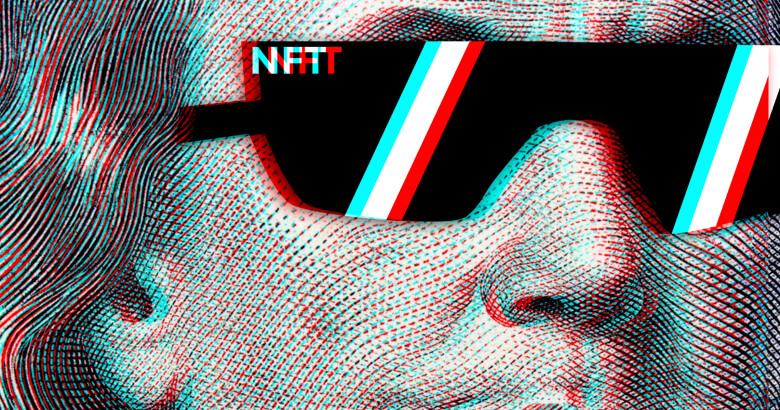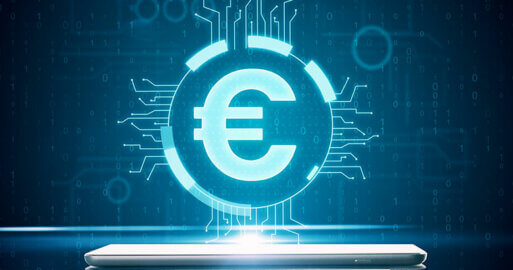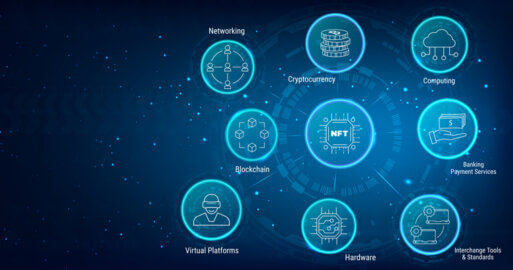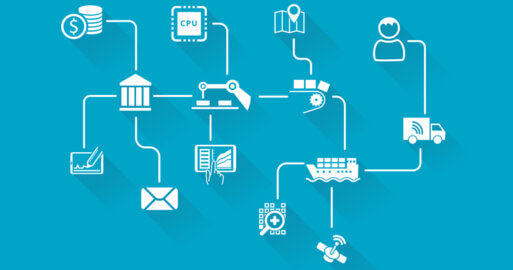NFTs are taking the world by storm. But what is an NFT?

The 20th edition of ArtReview’s Power 100, published in November 2021, had an unusual winner. For the first time ever, this annual list of influential artists included a non-human. If that weren’t enough, the entity ERC-721, otherwise known as an NFT, took the top spot.
It had been a good year for NFT. Just days previously, the British dictionary Collins crowned it word of the year. It says use of the abbreviation increased by over 11,000% in 2021.
So what exactly is this cultural superstar? And, why is it appearing on the SEEBURGER blog?
Let’s start by looking at the meaning of NFT. Collins define their word of the year as:
“a unique digital certificate, registered in a blockchain, that is used to record ownership of an asset such as an artwork or a collectible”.
ArtReview explains its entry straight in at number one with:
“With the apparent guarantee of title of ownership that NFTs promise, data becomes ownable…[so that] the market value of contemporary art lies not in the object, but the circulation of its image through digital culture”[1]
SEEBURGER is no stranger to the value of data. We also have several years of expertise in digitalisation.
But what is happening here? Let us define a few words of our own.
What is an NFT?
NFT is the short form of non-fungible token. In economics, fungible describes goods that are, essentially, interchangeable. 100g of gold has the same value whether it is in ingots, coins or another form. Shares in a company all receive the same value and they increase and decrease at the same rate as the other shares in that company. The €1 coin you find down the back of the sofa has the same value as each of the €1 coins in your wallet.
Therefore, non-fungible is non-interchangeable. Unique. A child’s favourite cuddly toy is non-fungible, as any parent who has searched for hours for the fun, funky, furry creature before bedtime can confirm. A non-fungible token is something absolutely unique.
However, we’re not talking about coins, gold or even teddy bears here.
The key to understanding all of this involves another word. In order to use a non-fungible token, you first need a blockchain.
What is a blockchain?
A blockchain is a chain of blocks. However, these aren’t building blocks, or even blocks of chocolate. They are blocks of data.
Sometimes, they actually contain data, while sometimes they refer to data stored securely elsewhere ‛off chain’. Every time this data is altered or added to in some way, a new block is added to the chain. The information in each block is cryptographically ‛hashed’ with a specific, non-transferrable code, and given a time stamp and a checksum to verify the code.
Crucially, each new code builds on the preceding codes, verifying its predecessors. This means that the codes themselves show whether a chain has been manipulated in some way, when it happened, and who was behind it.
If that weren’t enough, the blocks of data in a blockchain are automatically distributed between everyone participating in the chain, and they each receive a copy of the blockchain.
Essentially, it is a way of tracking a data journey. It can even track the journey taken by a physical item, if its various stops are digitally recorded by technology such as smart labels.
Why are NFTs so special?
A non-fungible token is something unique on a blockchain. And, for the digital artists in the millennial generation, adding an ownership certificate to a blockchain as a non-fungible token has been a game changer. Now, they have something they can sell. What’s more, collectors have something they can sell on, potentially for more than they originally paid. Just like in the physical art world. As ArtReview put it:
“for a generation of commercial visual artists, trained in graphic design, illustration, CGI and video, NFT offers the promise of a vehicle by which the price of one’s creative work can be controlled and traded, at a time when the economy of digital culture has tended to strip creatives of ownership and control[2]”
We’re not talking small change here. The digital artist Mike Winkelmann (aka Beeple) who started selling NFTs in February 2020, made $69,400,000 by auctioning off the NFT for his digital artwork series Everydays on March 11, 2021[3].
Other artists are also joining in. In the world of music, the band Kings of Leon released their album ‛when you see yourself’ as a limited edition by selling NFTs. They made $2m.[4] In a world in which streaming music seems to have become the norm, yet several artists have expressed dissatisfaction with streaming royalties, this is groundbreaking.
In a time in which, thanks to the COVID-19 pandemic, we have had to live out our lives more virtually than physically, non-fungible tokens have shaken up the cultural world. However, this isn’t the only way that we can harness the power of a blockchain to solve or prevent modern day problems.
How can you use blockchain in business?
Did you know, for example, that blockchain technology is being used to combat product piracy? As the European Union Intellectual Property Office and the Organisation for Economic Co-operation and Development have stated that up to 6.8 % of EU imports, equalling EUR 121 billion per year, are fake goods[5], there are enormous savings to be made in blocking piracy with blockchain.
A huge advantage of a blockchain is that it makes a journey traceable. While the art world is using it to track the certificate of ownership on an NFT, if you couple a blockchain with a QR code or similar on a label, it can also be used to track food items to their place of origin.
You could also use it alongside smart labels to track components for just-in-time production, or even to deal with the somewhat unexpected problem of how to track the empty crates and pallets which have been used to send goods and components to customers around the world. Some estimates state that it is not unusual for a company to lose 30% of these Returnable Transport Items a year[6].
Equally, if the date the goods arrive at a specific place is recorded on a block, as this is visible to everyone in the blockchain, it can be used to issue a proof of arrival, needed in some countries for tax purposes. Indeed, as every participant in a blockchain sees a copy of the chain, a country’s tax office need only join the blockchain to ensure that the invoice they are taxing has not been altered. Remember, it is always possible to trace who made changes and when.
It would also be possible to extract other data for tax purposes, such as the net worth of goods exported in a financial year by an online shop.
However, it’s not only the tax authorities who benefit from using a blockchain in e-invoicing. Another extremely useful feature in a blockchain is something called a smart contract.
What is a smart contract?
A contract is of course a binding agreement between two or more parties. Certain conditions need to be met in order for something to happen, be this payment, a service rendered, or the exchange of goods.
Despite there being several intelligent people working in the technology sector, these days, the technical world tends to use ‘smart’ to describe objects. Through programming, IoT technology such as sensors, and even AI elements such as machine learning, objects are now ‘smart’ enough to do tasks on their own. Autonomously. For smart contracts on a blockchain, this means that conditions are written into a data block, alongside a consequence. Once the blockchain records that these conditions have been met, it can authorise the consequence.
For a factoring company buying (bad) debt, once they have paid the agreed sum, the invoice rights transfer to the new owner and the blockchain ensures that there can be no double sales. The transfer is documented in the blockchain, where it is visible to the original issuer and any other stakeholders participating in the chain.
For our digital artists and the collectors buying their digital work, a smart contract would mean that ownership only transfers once the blockchain records payment. That protects both sides.
How do you access a blockchain?
This wide range of applications, by no means limited to the above, is possible because a blockchain is accessible. Some, like the NFT art examples above, are public blockchains, accessible to all. Others are private. A private blockchain is only available to defined users, and there are people responsible for maintenance and managing actions and access rights. This makes it eminently suitable for a number of business uses.
A number of participants use a platform to register their machine as a ‘peer’ on the blockchain. However, unlike classic data sharing technology like Electronic Data Interchange (EDI), participants don’t necessarily need a specific technical set up to join a private – or even a public – block chain. Instead, ‘there’s an app for that’ – as you can see in our article on the dynamic duo of invoice and blockchain – which opens up the technology to a wider public. Just like it monetises digital art for the hard-working artist while still keeping the art accessible to all.
How can SEEBURGER help?
SEEBURGER has over 35 years expertise in integrating data and technology. The power house behind the integrations, the SEEBURGER Business Integration Suite (BIS), can be connected through APIs to a peer for one or more blockchains, as well as to several blockchain-enabled platforms. Our agile, scalable integration platform can map, convert and generate the data required to participate in a blockchain. It can also manage and send data to a blockchain, which has come through an adapter, such as KAFKA, or from digital twins. It is even possible to use our integration platform to integrate a Peppol Access Point with the peer, or to let a blockchain peer automatically store off-chain data in a data lake such as HDFS, and reference it to the hash values from the blockchain.
The Business Integration Suite has been developed in house by us at SEEBURGER, a solid, established German company specialising in data integration. It is available as a cloud-based version, on-premises, or as a hybrid integration platform, and includes B2B, EDI, MFT, EAI and API integration functionality.
We also use Hyperledger Fabric 2 to set up private blockchains. This software can manage multiple blockchains, as well as enabling off-chain data. An organisation starts a fully functional blockchain by defining the first peer. Further peers can join as and when appropriate. Marketplaces, maintenance portals, delivery networks, platforms or web applications can be based on a blockchain, which supports a growing number of trading partners and use cases. You can also integrate peer nodes with other blockchain-enabled platforms such as Tradelens or WeTrade to work with banks and supply chain ecosystems
We would also be delighted to provide you with our expertise and products in areas which support blockchain use, such as SAP add ons (such as for creating smart RFID labels), IoT management and API management.
Blockchain is already proving to be a gamechanger in both our personal and business lives. SEEBURGER can help drive the digital transformation of your business by drawing on our three core strengths of technology, business and experience. Contact us for more information on how we can help you stay ahead and to lay the foundations for future growth.
[1] NFTs: the Year the Artwork Was Finally Dematerialised – ArtReview (accessed 2nd December 2021)
[2] NFTs: the Year the Artwork Was Finally Dematerialised – ArtReview
[3] Mike Winkelmann – Wikipedia
[4] Kings Of Leon Have Generated $2 Million On NFT Sales Of Their New Album | iHeart, accessed 12/01/2022
[5] 2020 Status Report on IPR Infringement,P5, June 2020, EUIPO, Executive Summary | ISBN 978-92-9156-277-0 doi: 10.2814/165063 TB-04-20-265-EN-N | © European Union Intellectual Property Office, 2020 | Reproduction is authorised provided the source is acknowledged
[6] Tracking returnable transport items reduces asset loss (acsisinc.com) Accessed 2nd December 2021
Thank you for your message
We appreciate your interest in SEEBURGER
Get in contact with us:
Please enter details about your project in the message section so we can direct your inquiry to the right consultant.
Written by: Melissa Kuhnert
Originally from the UK, Melissa Kuhnert joined the writing and editorial team at SEEBURGER at the end of 2020. With degrees in language and business, and a long interest in technology and effective communication, Melissa spends much of her time at SEEBURGER translating and creating blog posts for our English-language readers. Before joining SEEBURGER, she enjoyed a long career offering tailored, in-house English language training to corporate clients in mainly technical industries, and quite a lot of writing and translation. She estimates that she has taught in over 100 different companies, 5 universities, and toured so many clients’ production facilities, she owns her own steel-capped boots and safety glasses. Outside of work, Melissa enjoys exploring Germany, reading, watching British comedies, and firmly believes that a pun is its own reword.





